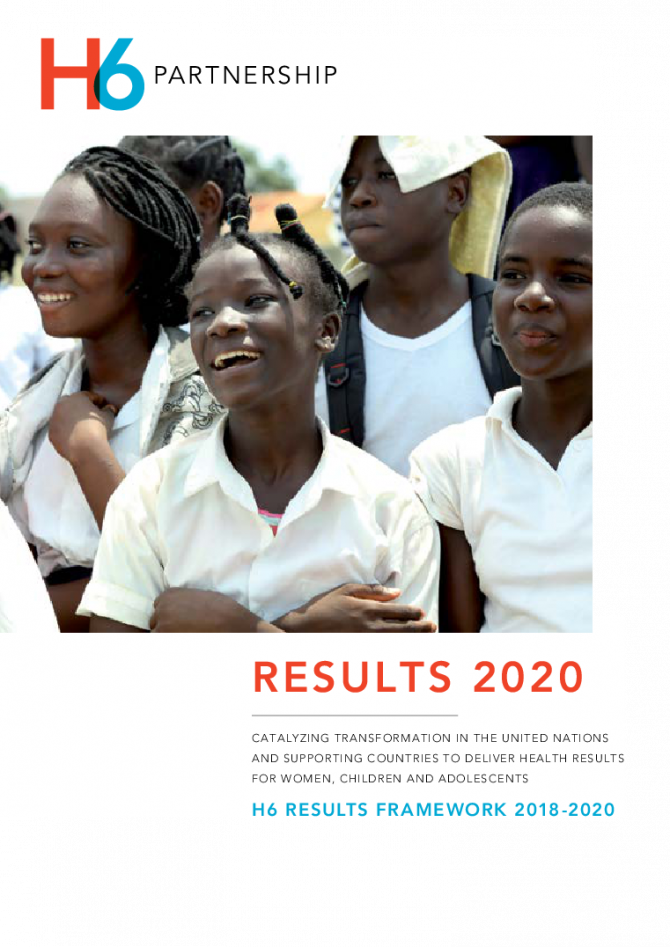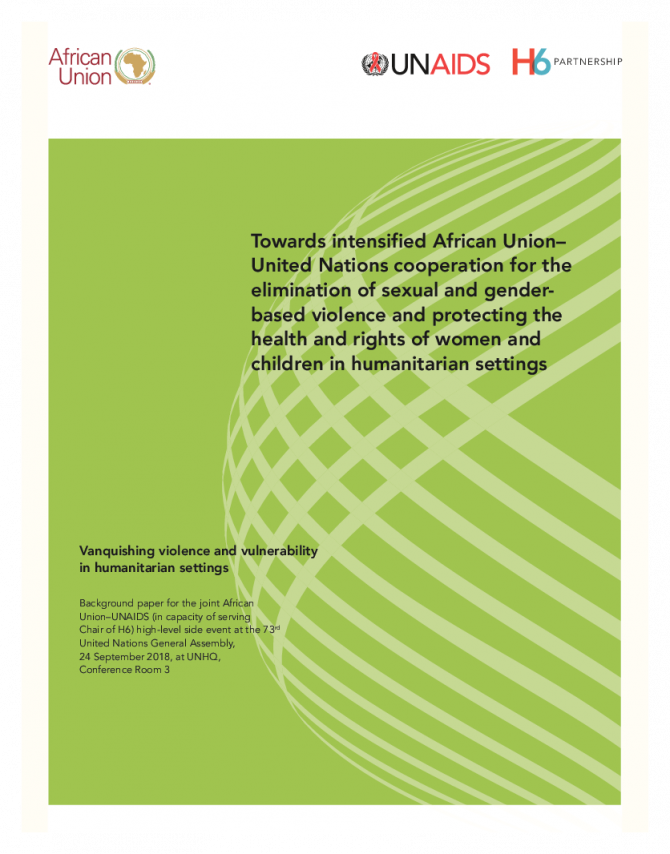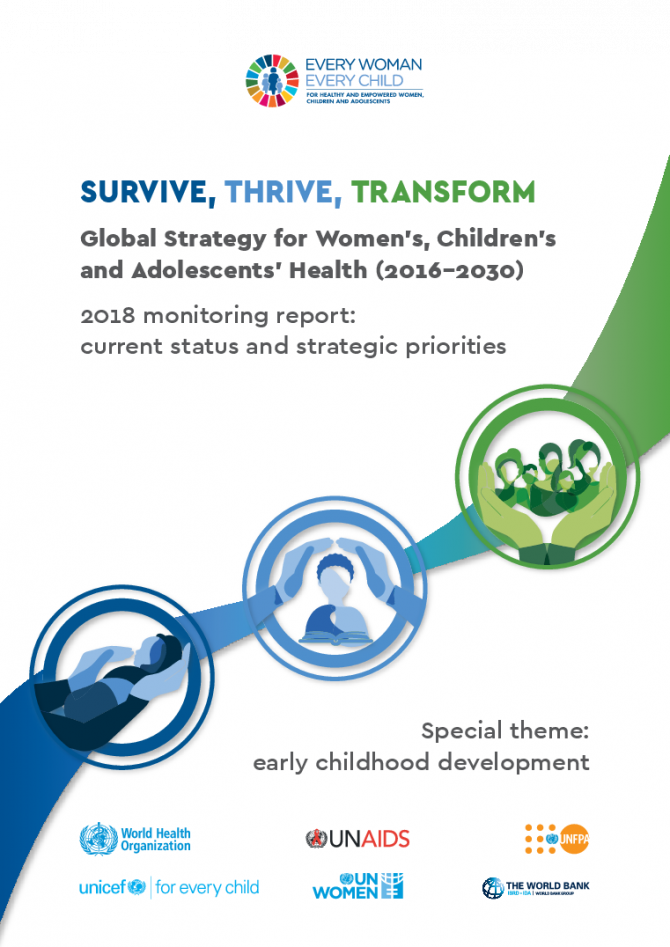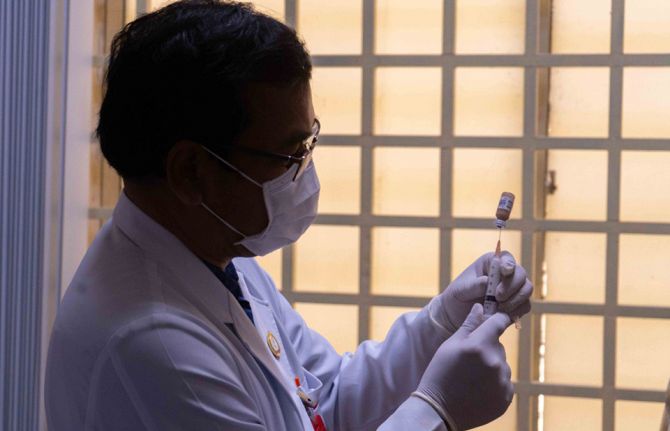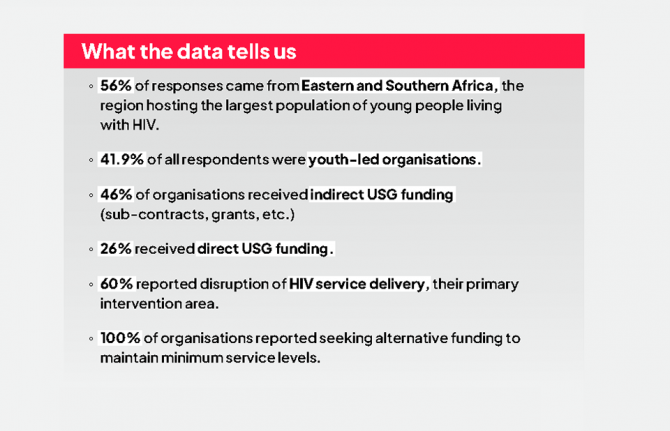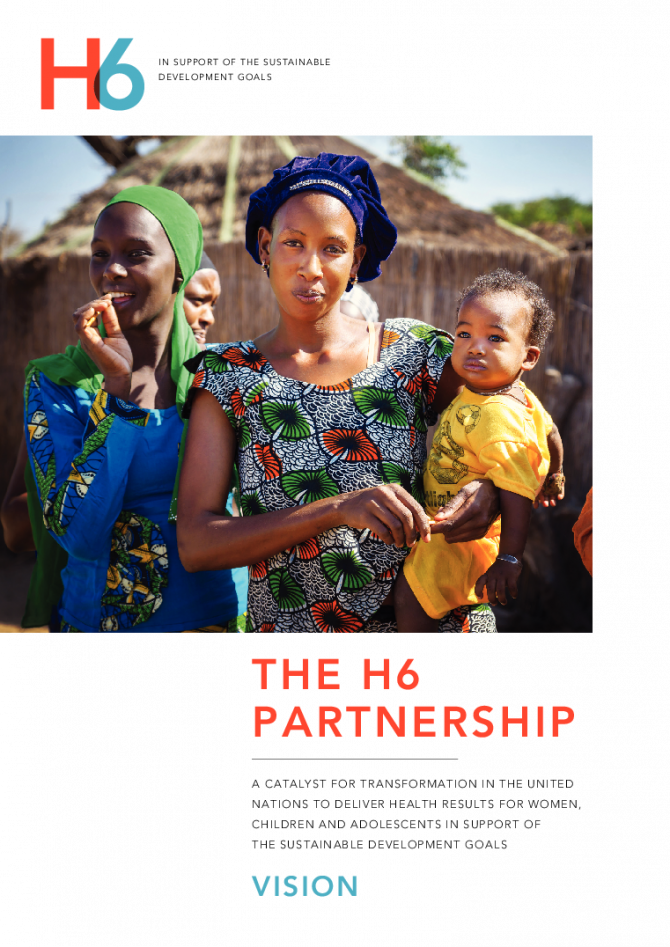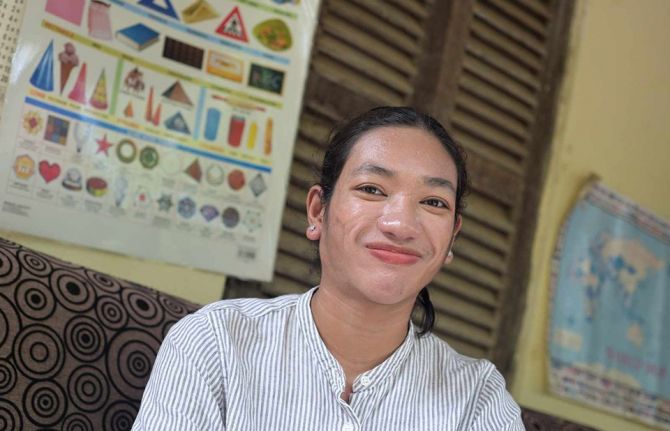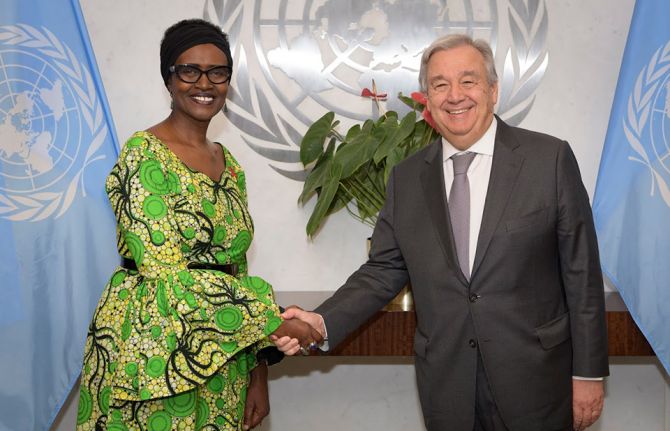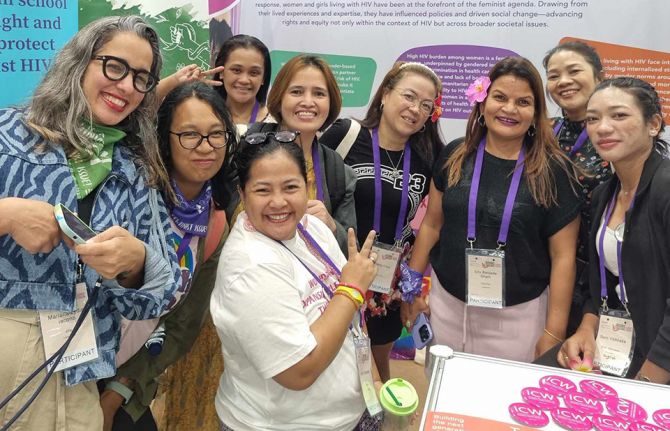Documents
Results 2020 — Catalyzing transformation in the United Nations and supporting countries to deliver health results for women, children and adolescents — H6 results framework 2018-2020
28 August 2018
Documents
Towards intensified African Union–United Nations cooperation for the elimination of sexual and gender-based violence and protecting the health and rights of women and children in humanitarian settings
24 September 2018
Documents
Survive, Thrive, Transform — Global Strategy for Women’s, Children’s and Adolescents’ Health (2016–2030) — 2018 monitoring report: current status and strategic priorities
28 May 2018
The report sets out the status of women’s, children’s and adolescents’ health, and on health systems and social and environmental determinants. Regional dashboards on 16 key indicators highlight where progress is being made or lagging. There is progress overall, but not at the level required to achieve the 2030 goals. There are some areas where progress has stalled or is reversing, namely neonatal mortality, gender inequalities and health in humanitarian settings. The report also highlights new evidence with a special focus on early childhood development as a foundation for health and well-being across the life course. There are new estimates on the causes of death in children older than 5 years; most are preventable. Each section of the report highlights strategic priorities, interventions and approaches that could help countries address challenges and accelerate progress.

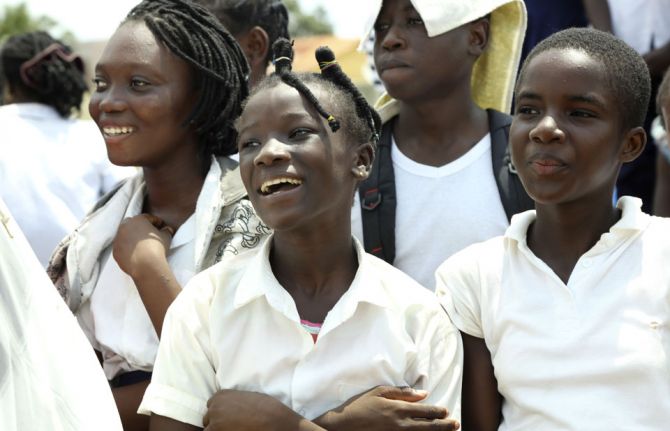
Feature Story
Heads of H6 agencies embrace new results framework
07 May 2018
07 May 2018 07 May 2018Around the world, many women, children and adolescents still have little or no access to quality health services and education, clean air and water, adequate sanitation and good nutrition. And far too many face violence and discrimination, unequal access to power and opportunity, and numerous barriers that harm their physical, mental and emotional health and well-being.
To accelerate change, the executive heads of the H6 partnership met on the sidelines of the United Nations System Chief Executives Board in London, United Kingdom, on 2 May and agreed a new results framework, H6 Results 2020. H6 Results 2020 aims to shape the H6 partnership into a trusted, valued source for technical support, strategic policy advice and best practices for the health and well-being of women, children and adolescents.
Developed under the chairpersonship of UNAIDS Executive Director Michel Sidibé, H6 Results 2020 is closely aligned with the Every Woman Every Child Every Adolescent Global Strategy and the 2020 Every Woman Every Child Partners’ Framework. H6 Results 2020 sets ambitious goals while committing to deliver on a number of concrete results for 2020.
“I am excited about our revitalized H6 partnership. As the technical arm of the Every Woman Every Child movement, we plan to further streamline and simplify the health architecture, coordinating with key partners to leverage political capital, technical expertise and advocacy for results for women, children and adolescents everywhere,” said Mr Sidibé.
Taking forward the vision endorsed by the executive heads in March 2018, H6 Results 2020 builds on the achievements of the H6 to date and reinforces existing mechanisms while strengthening United Nations mechanisms to support countries. It outlines how the H6 will harmonize efforts of the six H6 organizations and with key partners at the country, regional and global levels and will focus on the countries with the highest burdens of maternal, child and adolescent mortality and morbidity for intensified action.
“The H6 partnership plays a critical role in ensuring that countries focus on the health needs of women in an intersectional way, with laser-like focus on gender equality, human rights and other enablers, such as education,” said Phumzile Mlambo-Ngcuka, the Executive Director of UN Women.
By amplifying its added value, the H6 partnership seeks to serve as a living laboratory for United Nations reform—heeding the call of the United Nations Secretary-General for a more country-focused, coordinated, efficient and accountable development system better able to assist countries in implementing the 2030 Agenda for Sustainable Development.
“It is important that the United Nation comes together to focus its technical support on key priorities in a few high-burden countries, and what must drive our focus is results for people,” said Tedros Adhanom Ghebreyesus, the Director-General of the World Health Organization.
While committed to driving progress across a range of priorities for women, children and adolescent health, H6 Results 2020 puts clear emphasis on reaching adolescents. Adolescent girls and boys (aged 10–19 years) remain a particularly underserved population by the health and social programmes of many countries. Ensuring the health and well-being of adolescents is critical to delivering on the mandate of each of the H6 partners.
“The H6 partnership has proven that working in close collaboration and bringing different expertise and experience to the table is not only effective in enabling countries to deliver rights-based quality care for the women and girls left furthest behind, but also ensures strong country ownership,” said Natalia Kanem, the Executive Director of the United Nations Population Fund.
Related

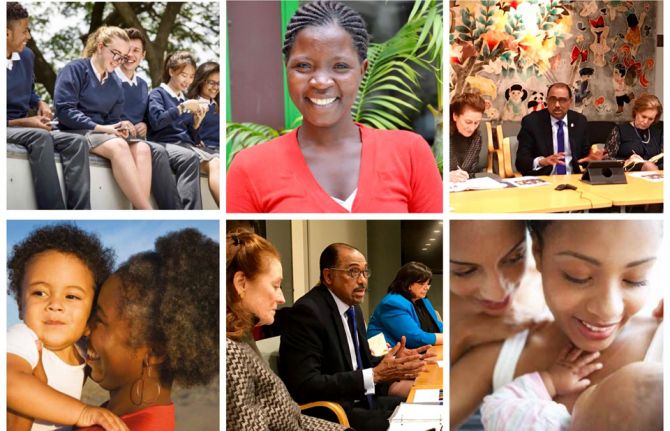
Feature Story
H6 commits to accelerate results for health
26 March 2018
26 March 2018 26 March 2018The H6 combines the strengths of six international organizations to help countries to realize the United Nations Secretary-General’s Every Woman Every Child strategy. The partnership mobilizes political commitment and resources to transform societies so that women, children and adolescents can realize their rights to the highest attainable standards of health and well-being.
High-level representatives of the six organizations met in New York, United States of America, to shape a shared vision for the H6. During the meeting, which took place on 21 March, health leaders committed to jointly deliver more and faster results in countries.
The Chair of the H6, Michel Sidibé, shared his vision for the partnership, including how it can evolve to meet the demands of the Sustainable Development Goals, including in humanitarian settings, and be a leading platform to advance United Nations reform.
“As a transformative platform, I see the H6 as an outstanding opportunity to rapidly bring United Nations reform to life and deliver results for every woman, child and adolescent on the ground,” said Michel Sidibé, Executive Director of UNAIDS.
The participants were united in their ambition to make the H6 a one-stop shop for countries for strategic policy advice, technical assistance and strategic information. Adolescent health, particularly for 10–18-year-olds, was discussed as a key focus area.
“I see an effective H6 partnership as an important way to drive health impact at the country level for all children, including by better addressing gaps in services for the age group from 10 to18 years old, and by planting the seeds of development in humanitarian contexts,” said Henrietta Fore, the Executive Director of the United Nations Children’s Fund.
The participants also committed to ensure policy-making in which communities have a voice and decided to build innovative partnerships with stakeholders beyond the United Nations.
Enhanced transparency and accountability of the H6 and reducing fragmentation and duplication in the United Nations system, as well as between the United Nations and the World Bank, will be key to success, as will a strong focus on joint reporting of results. The H6 will also work in close collaboration with the Global Financing Facility and the Partnership for Maternal, Newborn & Child Health.
“The United Nations Population Fund is strongly committed to the H6 partnership, which has proven that working in close collaboration and bringing different expertise and experience to the table is not only effective in enabling countries to deliver quality care for the women and girls left furthest behind, but also ensures strong country ownership,” said Natalia Kanem, the Executive Director of the United Nations Population Fund.
The H6 principals will now develop a results framework and reconvene in May to review and endorse it. They are aiming to adopt a road map to roll out new ways of working by mid-year.
Related
 “Who will protect our young people?”
“Who will protect our young people?”

02 June 2025

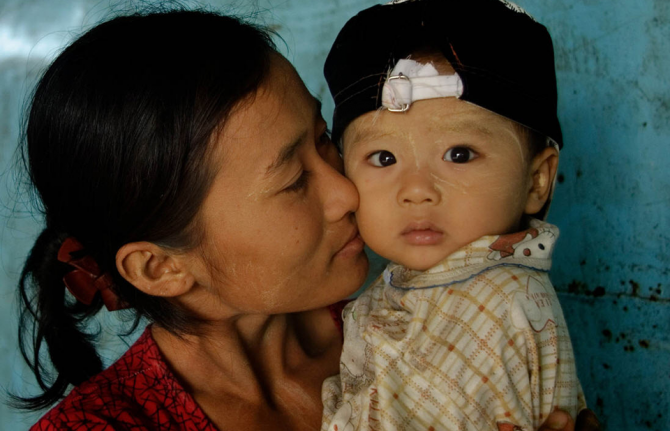
Update
Every woman and every child healthy and empowered
24 April 2017
24 April 2017 24 April 2017The health and well-being of women, children and adolescents are central to building peaceful, sustainable and inclusive societies. This is why in 2010 the then United Nations Secretary-General, Ban Ki-moon, launched Every Woman Every Child, a global movement to mobilize and intensify action by governments, multilateral organizations, the private sector and civil society to address the major health challenges facing women, children and adolescents around the world.
Showing his support for these efforts, on 21 April United Nations Secretary-General António Guterres became the third and senior Co-Chair of Every Woman Every Child, alongside the President of Chile, Michelle Bachelet, and the Prime Minister of Ethiopia, Hailemariam Desalegn. The announcement was made at a meeting of the Every Woman Every Child steering group, held on the margins of the spring meetings of the World Bank Group and the International Monetary Fund.
Every Woman Every Child unites its partners to deliver on an integrated agenda for women’s, children’s and adolescents’ health and well-being. It also puts into action a Global Strategy for Women’s, Children’s and Adolescents’ Health, a road map to ending all preventable deaths of women, children and adolescents within a generation and ensuring their well-being.
The core partners of Every Woman Every Child include the H6 (UNAIDS, the United Nations Population Fund, the United Nations Children’s Fund, UN Women, the World Health Organization and the World Bank Group), the Partnership for Maternal, Newborn and Child Health, the Global Financing Facility in support of Every Woman Every Child and the Every Woman Every Child Innovation Marketplace.
Over the past seven years, the movement has galvanized ambitious action and coordinated efforts across sectors. Since 2015, more than 60 country commitments and 150 multistakeholder commitments totalling more than US$ 27 billion have been made by the partners of Every Woman Every Child to deliver on the promises of a sustainable future for all by 2030.
Quotes
“Peace cannot exist without development and development cannot exist without health and well-being, for healthy and empowered women, children and adolescents can bring about the change needed to create a better future for all.”
“We have a unique opportunity to address the health challenges facing women, children and adolescents. I am committed to Every Woman Every Child and will continue to work to help ensure a better future for all.”
“We have made progress, but it has been uneven. We need to accelerate our efforts and actions to help women, children and adolescents to survive, thrive and transform.”

Press Statement
Harnessing the collective strengths of the UN system to reach every woman, child, and adolescent
18 March 2016 18 March 2016As part of the global effort to achieve the Millennium Development Goals (MDGs), countries around the world reported major gains in the health and wellbeing of women and children between 1990 and 2015. The global rate of maternal mortality fell by 47 per cent and child mortality declined by 49 per cent. However, any celebration of progress is tempered by the reality that millions of women, children, newborns, and adolescents continue to die every year; mostly from preventable causes. As the world transitions from the MDGs to the Sustainable Development Goals (SDGs), we must uphold our commitment to keep reproductive, maternal, newborn, child, and adolescent health (RMNCAH) at the heart of the global agenda. Fulfilling this promise is both a practical imperative and a moral obligation.
The UN Secretary-General's Global Strategy for Women's, Children's, and Adolescents' Health sets out a plan to give every woman, child, and adolescent the opportunity to not only survive, but to thrive and transform his or her community. Implementing the Global Strategy and achieving the SDG targets requires an unprecedented level of alignment and coordination amongst each and every one of us working in the field of RMNCAH.
On behalf of the six organizations responsible for promoting and implementing the global health agenda across the UN system, UNAIDS, UNFPA, UNICEF, UN Women, WHO, and the World Bank Group, we, the undersigned, stand united in our commitment to operationalize the Global Strategy.
Building on our tradition of working together to support countries in achieving the MDGs, we, as members of the H6 (previously known as the H4+), will provide coordinated technical support to country-led efforts to implement the Global Strategy and achieve the ambitious targets of the health-related SDGs. At the same time, we will continue to advocate for evidence-based RMNCAH programmes and policies at the global, regional, and national levels.
As the current H6 chair (2016-2018), UNAIDS will lead the partnership in fulfilling its mandate to leverage the strengths and capacities of each of the six member organizations in order to support high-burden countries in their efforts to improve the survival, health, and well-being of every woman, newborn, child, and adolescent.
As representatives of the H6, we renew our commitment to implement this mandate in support of the Global Strategy. We call on RMNCAH activists and advocates worldwide to join us in fulfilling this shared pledge to women, children, and adolescents everywhere.
Michel Sidibé, Executive Director, UNAIDS
Babatunde Osotimehin, Executive Director, UNFPA
Anthony Lake, Executive Director, UNICEF
Phumzile Mlambo-Ngcuka, Executive Director, UN Women
Margaret Chan, Director General, WHO
Tim Evans, Senior Director, Health, Nutrition and Population Global Practice, The World Bank Group
UNAIDS
The Joint United Nations Programme on HIV/AIDS (UNAIDS) leads and inspires the world to achieve its shared vision of zero new HIV infections, zero discrimination and zero AIDS-related deaths. UNAIDS unites the efforts of 11 UN organizations—UNHCR, UNICEF, WFP, UNDP, UNFPA, UNODC, UN Women, ILO, UNESCO, WHO and the World Bank—and works closely with global and national partners towards ending the AIDS epidemic by 2030 as part of the Sustainable Development Goals. Learn more at unaids.org and connect with us on Facebook, Twitter, Instagram and YouTube.
Press centre
Download the printable version (PDF)

